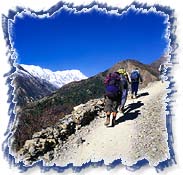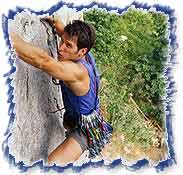Send Email Call Our Experts : 08046043349
|
Adventure in India and
more...
and
more... and
more... and
more...
 and
more... and
more... and
more...

and
more... India Special Tours
|
|
|
Home
» Adventure in India »
Trekking in India
|
 India
offers a treasure trove of unexplored trails for the trekking enthusiasts.
The mountain ranges here offer breathtaking, enthralling trekking routes. In
the vast amphitheater of the Indian mountain ranges, there are limitless
possibilities for trekking, mountaineering, skiing and river rafting trips.
Snow crested peaks, Alpine valleys, Chinnar laden slopes, glassy lakes,
crumbling monasteries perched high atop remote hills, deserted mountain
plateaus, ribbons of rushing waters cutting across granite, colourful prayer
flags and rosy cheeked children, vast swathes of green undisturbed except
for a handful of mountain sheep, exotic orchids growing wild, fields of
lavender, cascading waterfalls, lush tropical forests, tea plantations,
cardamom scented valleys and an incredible collection of breathtaking vistas
greet the visitor on every winding mountain curve.
India
offers a treasure trove of unexplored trails for the trekking enthusiasts.
The mountain ranges here offer breathtaking, enthralling trekking routes. In
the vast amphitheater of the Indian mountain ranges, there are limitless
possibilities for trekking, mountaineering, skiing and river rafting trips.
Snow crested peaks, Alpine valleys, Chinnar laden slopes, glassy lakes,
crumbling monasteries perched high atop remote hills, deserted mountain
plateaus, ribbons of rushing waters cutting across granite, colourful prayer
flags and rosy cheeked children, vast swathes of green undisturbed except
for a handful of mountain sheep, exotic orchids growing wild, fields of
lavender, cascading waterfalls, lush tropical forests, tea plantations,
cardamom scented valleys and an incredible collection of breathtaking vistas
greet the visitor on every winding mountain curve.  In India it is relatively easy to opt for a trek with all the luxurious
trappings for the most reasonable price. Travel agencies provide everything
from mountaineering equipment, guides, ponies, bearers, cooks, tents to just
about everything. A veritable caravan of ponies and horsemen are arranged to
carry all the necessities and also the heavy backpacks, leaving the trekker
without a care in the world and unencumbered to enjoy the serene atmosphere.
However if you so wish you could also do a trek alpine-style, carrying all
the food and equipment yourself , but for such a trek your planning needs to
be meticulous and the backpack as light as possible.
In India it is relatively easy to opt for a trek with all the luxurious
trappings for the most reasonable price. Travel agencies provide everything
from mountaineering equipment, guides, ponies, bearers, cooks, tents to just
about everything. A veritable caravan of ponies and horsemen are arranged to
carry all the necessities and also the heavy backpacks, leaving the trekker
without a care in the world and unencumbered to enjoy the serene atmosphere.
However if you so wish you could also do a trek alpine-style, carrying all
the food and equipment yourself , but for such a trek your planning needs to
be meticulous and the backpack as light as possible.